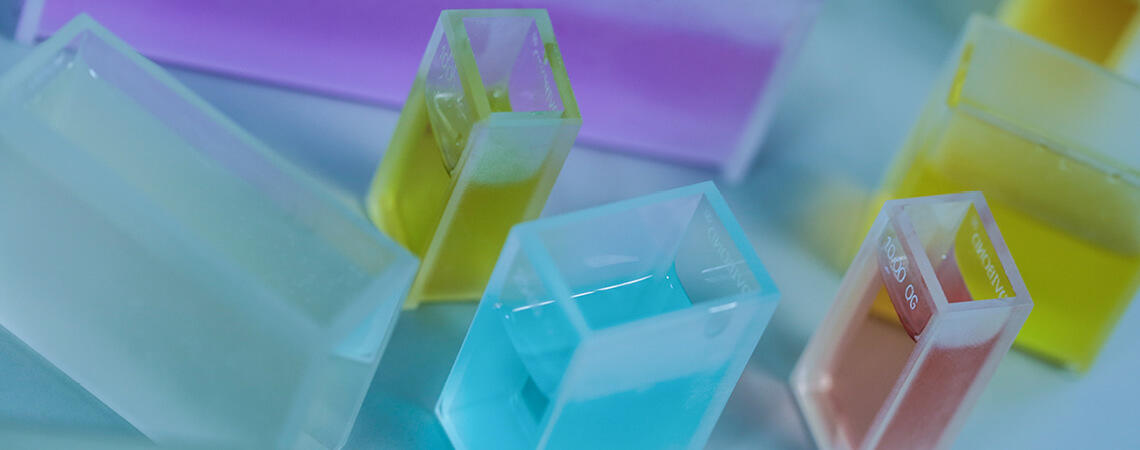Good Laboratory Practice
A Guide to Conformance
Cell Material
The material from which the cell is made may affect the measurements: plastic cells are more subject to scratching and discolouration and may be subject to chemical or thermal damage. Common materials are borosilicate or optical glass. Both are equally transparent to visible light, but borosilicate glass is more resistant to thermal shock. If you need to heat your samples to above ambient temperature to make them transparent for measurement, borosilicate cells in a heated instrument are recommended. This avoids incorrect results as samples cool or swirl due to temperature changes. Although more resistant, Borosilicate cells are not invulnerable: we strongly recommend samples are placed in the cell at room temperature and then heated in an oven to the required temperature.
Cell Cleaning
Any mess on the cell or the instrument leads to inaccurate results, particularly with automatic instruments whose enhanced precision makes them more sensitive to contamination.
If the cell is dirty, smeared or dusty, it will scatter light, making the detector see the sample as darker than it actually is. Always ensure that the clear ends of the cell are clean and completely free from fingerprints etc. These marks can be removed with a soft cloth. You should also clean a cell before using it the first time: the wrapping, while stopping dirt and dust, leaves a small residue on the surface of the glass.
Oil contents can be removed using a soft brush and by washing gently in lukewarm soapy water (hot water might cause the cells to crack). Particularly stubborn samples can be carefully removed with a solvent like isopropanol. Once the cell has been cleaned, flush it first with tap water, then rinse in de-ionised water to remove any tap water minerals. Turn the cell upside-down to drain and dry.
While damage or dirt on a cell is easily visible, the same may not be true of contamination of a sample chamber, which can build up over time inside the instrument and is not easily visible. To guard against this, it is important to routinely carry out conformance checks using liquid or glass references. These ensure that an instrument’s long-term accuracy is monitored and maintained
Certified Liquid References
Liquid references have several advantages, most importantly that the instrument is being tested using standards similar in nature to the samples being measured. Specifically, liquid references can highlight potential problems in sample preparation and measurement procedures (use of the correct path length, cleanliness of the cell, its correct positioning), as well as the overall accuracy of the instrument.
Glass Conformance Filters
Glass standards have advantages in their ease of use and shelf life. They are also impossible to spill, take up less space and are easily cleaned. Individual filters and sets for a range of instruments and colour scales are available. Each is provided with a certificate of conformity showing the certified value, acceptable tolerances for the scale, nominal value and instrument.
Cell Path Length
A vital aspect of correct practice is to ensure the right cell is used for the measurement. Some colour scales incorporate a path length correction into the method. Here it is possible to use different path length cells and enter this path length into the instrument’s settings to calculate the correct result. In other cases, one must either use the default path length, where there is one, or, when you have an option, always report the result with the actual cell used. Details of which path lengths are recommended for which scales can be found on the Tintometer® Group’s website.
Service and Calibration
Older instruments should be sent back-to-base for calibration. On return, you should receive a certificate of calibration to ISO 9001 for the instrument, listing the standards used, their pass/fail tolerances and the measurements given at the time of the test.
Remote Calibration (RCMSi)
An alternative process is RCMSi where tightly controlled calibration liquids are measured via the Calibration function of a Lovibond® PFXi. Data is electronically communicated to a secure server and compared to Master Data. If the data passes within tolerance, a Certificate of Calibration is made available to the user. This ensures a PFXi instrument is operating correctly and fully calibrated using ISO 17025 certified standards. Using this system allows the operator to get the confidence of a back-to-base calibration, without needing to transport the instrument: saving cost, time and environmental impact.
Confidence in Results
By using one or more methods of verification, you can be confident that the results that your instrument is giving are consistent over time, as well as with other instruments reading to the same test methods. Ensuring the accuracy of an instrument prevents potentially costly mistakes, immediately picking up deviations so fixes can be applied.
